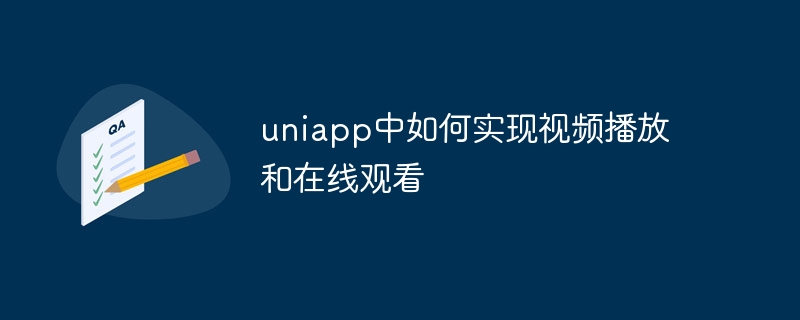How to implement video playback and online viewing in uniapp

uniapp is a cross-platform application framework developed based on Vue.js, which can be used to develop applications that are suitable for multiple platforms at the same time. It is very easy to implement video playback and online viewing in uniapp, just use the built-in Video component. The following will introduce in detail how to implement video playback and online viewing in uniapp, and give specific code examples.
- Introducing the Video component
In the uniapp page, you first need to introduce the Video component. You can import the Video component in the vue file of the page, as shown below:
<template>
<view>
<video :src="videoUrl"></video>
</view>
</template>
<script>
export default {
data() {
return {
videoUrl: 'http://www.example.com/video.mp4' // 视频的URL地址
}
}
}
</script>- Bind video URL
In the above code, we define a videoUrl attribute to save the URL address of the video. You can save the URL address of the video in this attribute according to actual needs. This URL address can be a link to an online video or the path to a local video. - Play video
In the above code, we use the Video component and bind the videoUrl attribute to the src attribute of the Video component through the v-bind instruction to implement the video playback function. In uniapp, the Video component has built-in some basic video playback control functions, such as play, pause, progress bar, etc., which can be used directly on the page. - Watch online
To watch videos online, you can directly use the link of the online video as the value of the videoUrl attribute. In uniapp, the Video component supports playing most video formats, including MP4, H.264, WebM, etc.
If you want to watch videos from the back-end API online, after obtaining the URL address of the video, dynamically bind it to the videoUrl attribute. The specific implementation method can be adjusted according to your own project needs.
In summary, through the above steps, we can implement video playback and online viewing functions in uniapp. Just use the built-in Video component and dynamically bind the URL address of the video. In this way, videos in various formats can be played in applications developed by uniapp. Hope this article can be helpful to you!
The above is the detailed content of How to implement video playback and online viewing in uniapp. For more information, please follow other related articles on the PHP Chinese website!

Hot AI Tools

Undresser.AI Undress
AI-powered app for creating realistic nude photos

AI Clothes Remover
Online AI tool for removing clothes from photos.

Undress AI Tool
Undress images for free

Clothoff.io
AI clothes remover

AI Hentai Generator
Generate AI Hentai for free.

Hot Article

Hot Tools

Notepad++7.3.1
Easy-to-use and free code editor

SublimeText3 Chinese version
Chinese version, very easy to use

Zend Studio 13.0.1
Powerful PHP integrated development environment

Dreamweaver CS6
Visual web development tools

SublimeText3 Mac version
God-level code editing software (SublimeText3)

Hot Topics
 1385
1385
 52
52
 What are the different types of testing that you can perform in a UniApp application?
Mar 27, 2025 pm 04:59 PM
What are the different types of testing that you can perform in a UniApp application?
Mar 27, 2025 pm 04:59 PM
The article discusses various testing types for UniApp applications, including unit, integration, functional, UI/UX, performance, cross-platform, and security testing. It also covers ensuring cross-platform compatibility and recommends tools like Jes
 What debugging tools are available for UniApp development?
Mar 27, 2025 pm 05:05 PM
What debugging tools are available for UniApp development?
Mar 27, 2025 pm 05:05 PM
The article discusses debugging tools and best practices for UniApp development, focusing on tools like HBuilderX, WeChat Developer Tools, and Chrome DevTools.
 How can you reduce the size of your UniApp application package?
Mar 27, 2025 pm 04:45 PM
How can you reduce the size of your UniApp application package?
Mar 27, 2025 pm 04:45 PM
The article discusses strategies to reduce UniApp package size, focusing on code optimization, resource management, and techniques like code splitting and lazy loading.
 How can you optimize images for web performance in UniApp?
Mar 27, 2025 pm 04:50 PM
How can you optimize images for web performance in UniApp?
Mar 27, 2025 pm 04:50 PM
The article discusses optimizing images in UniApp for better web performance through compression, responsive design, lazy loading, caching, and using WebP format.
 How can you use lazy loading to improve performance?
Mar 27, 2025 pm 04:47 PM
How can you use lazy loading to improve performance?
Mar 27, 2025 pm 04:47 PM
Lazy loading defers non-critical resources to improve site performance, reducing load times and data usage. Key practices include prioritizing critical content and using efficient APIs.
 What are some common patterns for managing complex data structures in UniApp?
Mar 25, 2025 pm 02:31 PM
What are some common patterns for managing complex data structures in UniApp?
Mar 25, 2025 pm 02:31 PM
The article discusses managing complex data structures in UniApp, focusing on patterns like Singleton, Observer, Factory, and State, and strategies for handling data state changes using Vuex and Vue 3 Composition API.
 How does UniApp handle global configuration and styling?
Mar 25, 2025 pm 02:20 PM
How does UniApp handle global configuration and styling?
Mar 25, 2025 pm 02:20 PM
UniApp manages global configuration via manifest.json and styling through app.vue or app.scss, using uni.scss for variables and mixins. Best practices include using SCSS, modular styles, and responsive design.
 How do you handle the back button in UniApp?
Mar 26, 2025 pm 11:07 PM
How do you handle the back button in UniApp?
Mar 26, 2025 pm 11:07 PM
The article discusses handling the back button in UniApp using the onBackPress method, detailing best practices, customization, and platform-specific behaviors.




